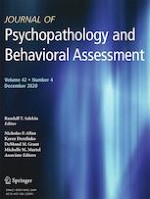19-05-2020
Abnormal Cortical Activation in Visual Attention Processing in Sub-Clinical Psychopathic Traits and Traumatic Brain Injury: Evidence from an fNIRS Study
Gepubliceerd in: Journal of Psychopathology and Behavioral Assessment | Uitgave 4/2020
Log in om toegang te krijgenAbstract
Psychopathy is characterized by impulsivity, antisocial behavior, and deficient affect, and it has also been associated with attention deficits. However, studies of the relationship between psychopathy and the underlying neurophysiology of attention have yielded mixed results, which may be due to the heterogeneous nature of psychopathy as well as the failure to account for the influence of a history of traumatic brain injury (TBI). This study investigated whether the neurophysiology of attention is differentially associated with individual psychopathic traits, and whether a history of TBI may change these associations. Psychopathic traits were assessed among college students (age = 18–26 years; 63% male) with (n = 20) and without (n = 23) a history of mild TBI. Brain activation in bilateral middle frontal gyri (MFG) was measured with functional near-infrared spectroscopy (fNIRS) during a block-designed (rest and task blocks) visual sustained attention task. Relative to non-TBI controls, participants with a history of TBI showed significantly more activation in the right MFG in response to the task. In participants without a history of TBI, self-centered impulsivity was positively associated with activation in the right MFG during the rest blocks, while coldheartedness was negatively associated with activation in the left MFG during the task. No relationships between psychopathic traits and MFG activation were found in those with a history of TBI. These findings indicate that MFG hypoactivation and hyperactivation may contribute to the affective coldness and impulsivity of psychopathy, respectively, and highlight the importance of assessing TBI in psychopathy research.
